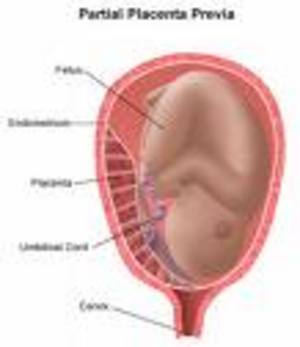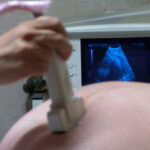What is Placenta Previa?
Placenta previa is a condition in which the placenta of a pregnant woman implants and covers, partially covers, or lies near, the woman’s cervix. The “pre” in “previa” simply means “before”–the placenta is placed before the baby. This condition affects 1 out of 200 pregnant women and their unborn babies. In most cases of placenta previa, as the uterus and baby grow, the placenta will move up and away from the cervix and cause no further problems. Often, if placenta previa is suspected during a first trimester ultrasound, follow-up ultrasounds will be ordered to determine that the placenta has changed location. If your doctor has mentioned placenta previa as a possibility, and you are in your first or second trimester, do not be alarmed. The vast majority of previa cases (90%) correct themselves before delivery. However, when the placenta does not change location by the latter part of pregnancy, the condition becomes very serious. Placenta previa, if not treated, can cause excessive bleeding during delivery, and possibly fetal or maternal death. There are four types of placenta previa:
Type I or low lying: The placenta lies low in the uterus, but does not cover any area of the cervix.
Type 2 or marginal: The placenta touches, but does not cover the cervix.
Type 3 or partial: The placenta partially covers the cervix.
Type 4 or complete: The cervix is completely covered by the placenta. (This is the most serious as the bleeding which can signal previa will not begin until labor.)
What are the Symptoms?
The inappropriate location of the placenta will cause painless, bright red bleeding which may be very light or very heavy. Bleeding which occurs after 24 weeks gestation will lead your doctor to suspect placenta previa. Ultrasound is most often used to confirm the diagnosis.
What Causes the Condition?
The causes of placenta previa are not known for certain. However, several risk factors have been determined:
1. Previous abortion, caesarean delivery, or placenta previa
2. Numerous previous, closely spaced pregnancies
3. Woman’s age is under 20 or over 30 (risk increases with age after 30)
4. Cigarette or cocaine use by the mother
How is Placenta Previa Treated?
If placenta previa is diagnosed late in pregnancy, you will be closely monitored and have regular ultrasounds. Women with types 1, 2 or 3 previa will begin to experience bleeding towards the end of their pregnancies, though most will not until around 37 weeks. If you experience bleeding earlier than this, you will be put on pelvic rest (no sex) and told to avoid any strenuous activity. You may need to be monitored in a hospital until your baby is ready to be born. The birth will always be by C-section to avoid the risk of heavy bleeding during delivery. If you experience heavy bleeding, a blood transfusion may be necessary.
Placenta previa, though very serious, is relatively rare and can be treated if properly diagnosed. It is essential that you receive quality prenatal care to prevent a bad outcome as a result of having an undiagnosed previa. If your placenta previa continues into your third trimester, prepare yourself mentally for a caesarean delivery. For many years, vaginal deliveries of women with placenta previa would result in maternal or certainly fetal death. The opportunity to have a healthy baby via C-section is a gift from God and a miracle of medical science.



